Swarm technology revolutionizes large-scale disaster evaluations by deploying autonomous robot teams that mimic insect behaviors. You'll see rapid data collection and wide area coverage, allowing for swift assessment of extensive disaster zones. Real-time mapping and obstacle avoidance capabilities guarantee thorough and safe exploration. The technology's communication network redundancy and resource allocation optimization enhance reliability and efficiency. It integrates seamlessly with existing systems, improving overall disaster response. Swarm deployments are cost-effective, reducing the need for human personnel in hazardous areas. This innovative approach offers a game-changing solution for disaster management, with potential benefits that extend far beyond initial expectations.
Swarm Technology Basics
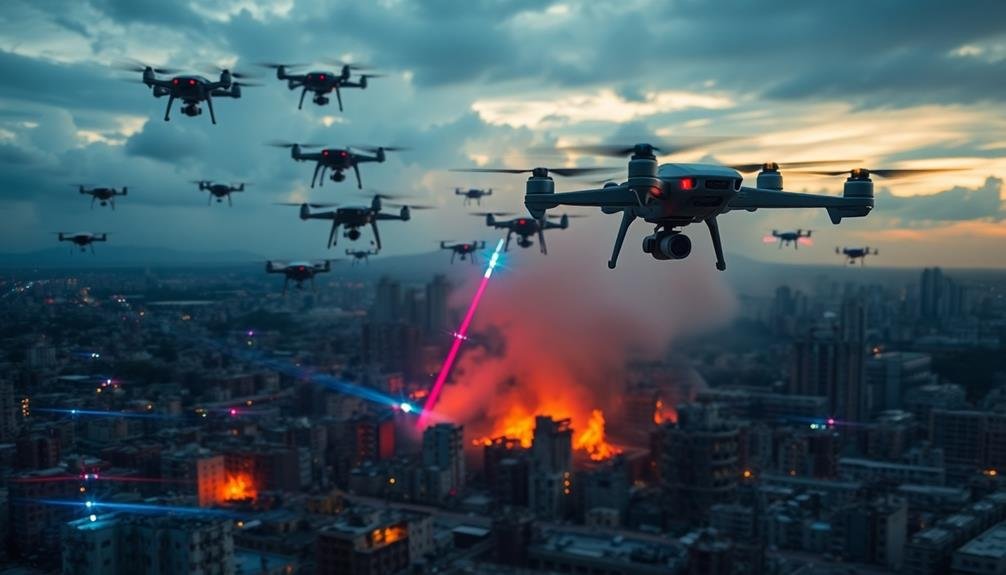
Swarm technology draws inspiration from the collective behavior of insects and animals in nature. It's a form of artificial intelligence that mimics how groups of simple organisms work together to achieve complex tasks.
In swarm systems, you'll find numerous small, autonomous units that communicate and cooperate, creating a more intelligent and adaptable whole. These individual units, often called agents or bots, follow simple rules but interact with each other and their environment.
This interaction leads to emergent behavior, where the swarm can solve problems that would be too difficult for any single unit. You'll see this in action when swarms navigate obstacles, optimize routes, or gather information efficiently.
Key components of swarm technology include decentralized control, local interactions, and adaptability. There's no central commander; instead, each unit makes decisions based on its immediate surroundings and communication with nearby units.
This decentralized approach makes swarms robust and scalable. They can continue functioning even if some units fail, and you can easily add or remove units without reprogramming the entire system.
Rapid Data Collection

In disaster scenarios, rapid data collection becomes essential for effective response and recovery efforts. Swarm technology excels at this task, allowing you to gather vast amounts of data quickly and efficiently. You'll deploy multiple drones or robots simultaneously, each equipped with sensors and cameras to capture real-time information about the affected area.
These swarms can cover large territories in a fraction of the time it would take human teams. They'll navigate through debris, scan buildings for structural damage, and identify potential hazards. You'll receive a thorough overview of the situation within hours, enabling faster decision-making and resource allocation.
The data collected by swarms is typically more accurate and detailed than traditional methods. You'll get high-resolution imagery, thermal scans, and environmental readings that paint a complete picture of the disaster's impact. This information helps you prioritize rescue efforts, assess infrastructure damage, and plan recovery strategies.
Moreover, swarms can access areas too dangerous for human responders, reducing risks to personnel. You'll be able to monitor evolving situations continuously, adapting your response as new data comes in.
Wide Area Coverage

A key advantage of swarm technology in disaster evaluations is its ability to cover vast areas rapidly. You'll find that swarms of drones or robots can disperse across large regions, simultaneously evaluating damage and gathering critical data. This wide-area coverage dramatically reduces the time needed for thorough evaluations.
When you deploy swarm technology, you're leveraging the power of distributed systems. Each unit in the swarm can focus on a specific section of the affected area, ensuring no spot is overlooked. This approach is particularly effective in scenarios where time is of the essence, such as search and rescue operations or evaluating structural damage after an earthquake.
| Disaster Type | Traditional Coverage | Swarm Coverage |
|---|---|---|
| Flood | Limited by terrain | Thorough |
| Wildfire | Restricted by smoke | Aerial overview |
| Earthquake | Slow ground surveys | Rapid mapping |
| Hurricane | Delayed access | Immediate data |
You'll appreciate how swarm technology overcomes obstacles that typically hinder traditional evaluation methods. It's not constrained by road conditions, dangerous terrain, or visibility issues. Instead, it provides a bird's-eye view of the entire disaster zone, allowing for more informed and timely decision-making in critical situations.
Real-Time Mapping Capabilities
You'll find real-time mapping capabilities essential for immediate terrain assessment in disaster scenarios.
As swarms of drones survey affected areas, they can rapidly generate up-to-date maps of the changing landscape.
These maps enable you to identify dynamic hazards as they emerge, allowing for swift adaptation of rescue and relief efforts.
Immediate Terrain Assessment
One of the most essential capabilities of swarm technology in disaster evaluation is its ability to provide immediate terrain assessment through real-time mapping. You'll find that swarms of drones can quickly scan vast areas affected by natural disasters, creating up-to-the-minute topographical data. This rapid assessment allows emergency responders to identify dangerous terrain, blocked routes, and areas of immediate concern.
As you deploy these swarms, they'll use advanced sensors and imaging technology to detect changes in landscape, structural damage, and potential hazards. They can spot landslides, flooding, collapsed buildings, and other obstacles that might impede rescue efforts. The data they collect is instantly processed and transmitted to command centers, giving you a thorough overview of the disaster zone.
You'll appreciate how this immediate terrain assessment helps prioritize resources and plan effective response strategies. It enables you to direct rescue teams to the most essential areas, avoiding dangerous zones and identifying safe access routes. This real-time information is vital for making quick, informed decisions that can save lives and minimize further damage in the critical hours following a disaster.
Dynamic Hazard Identification
Swarms of drones excel at dynamic hazard identification, offering real-time mapping capabilities that go beyond initial terrain assessment. As you deploy these swarms, they'll continuously scan the disaster area, detecting and tracking evolving threats. This real-time data allows you to make informed decisions quickly, potentially saving lives and resources.
The drones' collective intelligence enables them to adapt to changing conditions, identifying new hazards as they emerge. You'll receive up-to-the-minute information on:
- Structural integrity changes in buildings
- Shifting debris fields or landslides
- Sudden chemical leaks or fire outbreaks
With this dynamic hazard identification, you can prioritize rescue efforts and allocate resources more effectively. The swarm's ability to cover large areas simultaneously means you'll have a thorough view of the disaster zone at all times.
You'll also benefit from the swarm's redundancy. If one drone fails, others will continue the mission, ensuring uninterrupted hazard monitoring. This resilience is essential in unpredictable disaster environments where equipment failure is a real risk.
Obstacle Avoidance in Disaster Zones

You'll find that obstacle avoidance in disaster zones relies heavily on intelligent navigation systems.
These systems employ real-time path planning algorithms to help swarm units navigate through unpredictable and hazardous environments.
Intelligent Navigation Systems
Numerous challenges arise when deploying swarm robots in disaster zones, making intelligent navigation systems vital for their effectiveness. You'll find that these systems enable swarm robots to autonomously navigate through complex, ever-changing environments while avoiding obstacles and optimizing their routes.
Intelligent navigation systems in swarm technology incorporate:
- Real-time mapping and localization algorithms
- Distributed decision-making processes
- Adaptive path planning based on environmental data
You'll see how these systems allow robots to collectively create and update maps of the disaster area, sharing information with each other and human operators. They can identify safe passages, detect potential hazards, and adjust their routes accordingly. This adaptability is essential in disaster zones where conditions can change rapidly.
You'll appreciate how intelligent navigation systems enhance the swarm's efficiency and safety. They minimize the risk of collisions, prevent robots from becoming trapped or damaged, and guarantee thorough coverage of the affected area.
Real-Time Path Planning
Real-time path planning is a fundamental aspect of intelligent navigation systems for swarm robots in disaster zones. It allows the swarm to navigate through complex, dynamic environments while avoiding obstacles and potential hazards. You'll find that this capability is vital for effective disaster evaluation, as it enables robots to adapt quickly to changing conditions.
In disaster zones, you can't rely on pre-programmed routes. Instead, swarm robots use sensors and algorithms to continuously assess their surroundings and make split-second decisions. They'll detect obstacles, calculate ideal paths, and communicate with other members of the swarm to coordinate movements. This real-time adaptability guarantees that the robots can navigate through debris, collapsed structures, and unstable terrain.
You'll notice that obstacle avoidance is a key component of real-time path planning. Swarm robots use various techniques, such as potential field methods, sampling-based algorithms, and neural networks, to identify and circumvent obstacles.
They'll also prioritize safety, considering factors like terrain stability and potential hazards when plotting their course. This advanced path planning allows swarm robots to explore disaster areas efficiently, gather critical data, and assist in search and rescue operations without endangering human responders.
Multi-Sensor Fusion Techniques
While real-time path planning is essential, multi-sensor fusion techniques play an equally important role in obstacle avoidance for swarm robots in disaster zones. You'll find that these techniques combine data from multiple sensors to create a more accurate and thorough understanding of the environment.
By integrating information from various sources, swarm robots can navigate complex and unpredictable disaster areas with greater precision and safety.
Multi-sensor fusion allows robots to:
- Detect obstacles that may be invisible to a single sensor type
- Compensate for individual sensor limitations or failures
- Improve accuracy in identifying potential hazards
You'll see swarm robots equipped with a combination of sensors, such as LiDAR, cameras, ultrasonic sensors, and infrared detectors. These work together to provide a robust perception of the surroundings.
As the robots move through disaster zones, they'll continuously process and fuse sensor data, enabling them to react quickly to changes in the environment. This capability is vital when dealing with unstable structures, debris, or dynamic obstacles that may pose risks to the swarm or survivors.
Autonomous Decision-Making

Autonomous decision-making lies at the heart of swarm technology's effectiveness in disaster evaluations. When you deploy a swarm of robots or drones, each unit must be capable of making independent choices based on its environment and mission parameters. This decentralized approach allows the swarm to adapt quickly to changing conditions without constant human intervention.
You'll find that swarms use algorithms inspired by natural systems, like ant colonies or bird flocks. These algorithms enable individual units to react to local information and communicate with nearby members. As a result, the swarm can self-organize and make collective decisions that often surpass the capabilities of a single, more complex robot.
In disaster scenarios, you'll see swarms autonomously deciding how to distribute themselves across an area, identify priority targets, and allocate resources. They can reroute around obstacles, avoid dangerous zones, and even sacrifice individual units for the greater mission.
This autonomous behavior guarantees that your disaster evaluation continues even if communication with a central command is lost or individual units fail. It's this resilience and adaptability that makes swarm technology so powerful for large-scale disaster assessments.
Communication Network Redundancy

You'll find that swarm technology excels at creating robust communication networks through self-healing mesh structures.
These networks enable distributed data transmission, ensuring information flows even if individual units fail.
Self-Healing Mesh Networks
In the wake of disaster, maintaining communication is paramount. Self-healing mesh networks offer a robust solution to this challenge. You'll find these networks adapting and reconfiguring themselves automatically when nodes fail or connections are disrupted. This resilience guarantees that essential information continues to flow even in the most challenging environments.
When you deploy swarm technology with self-healing mesh capabilities, you're creating a dynamic, decentralized communication infrastructure. Each drone or device in the swarm acts as both a transmitter and a receiver, forming a web of interconnected nodes. If one node goes down, the network reroutes data through alternative paths, maintaining connectivity.
Key advantages of self-healing mesh networks in disaster evaluations include:
- Increased reliability and redundancy
- Scalability to cover large areas
- Reduced dependency on centralized infrastructure
You'll appreciate the network's ability to expand or contract as needed, adapting to the changing scope of the disaster. This flexibility allows for efficient resource allocation and improved situational awareness.
Distributed Data Transmission
Building on the concept of self-healing mesh networks, distributed data transmission takes network redundancy to the next level. In this system, you'll find that data isn't stored or transmitted through a single central point. Instead, it's broken down into smaller chunks and distributed across multiple nodes in the swarm.
This approach offers several advantages for disaster evaluations. You'll experience improved reliability, as the loss of one or more nodes won't compromise the entire dataset. The system's also more efficient, allowing for faster data transmission and reduced bandwidth requirements.
You can expect enhanced security too, as it's harder for malicious actors to intercept or tamper with scattered data fragments.
In disaster scenarios, you'll appreciate how this technology enables real-time data sharing among first responders, even in areas with limited infrastructure. It facilitates the rapid collection and dissemination of vital information, such as damage assessments, resource allocation, and victim locations.
You'll find that this distributed approach markedly improves the speed and effectiveness of disaster response efforts, ultimately saving more lives and minimizing damage.
Multi-Channel Information Flow
A fundamental component of swarm technology in disaster evaluations is multi-channel information flow, which guarantees communication network redundancy. You'll find that this approach assures uninterrupted data transmission even when certain channels fail. By utilizing multiple communication pathways, swarm robots can maintain connectivity and share essential information about disaster-affected areas.
In a multi-channel system, you're not relying on a single method of communication. Instead, you're leveraging various technologies to create a robust network. This redundancy is important in disaster scenarios where infrastructure damage can disrupt traditional communication channels.
Here's why multi-channel information flow is necessary:
- It enhances resilience against network failures
- It allows for load balancing, preventing bottlenecks
- It enables prioritization of significant data across different channels
You'll notice that this approach greatly improves the overall reliability of swarm operations. By diversifying communication methods, you're assuring that essential information reaches decision-makers even in the most challenging circumstances.
This redundancy is key to maintaining situational awareness and coordinating effective disaster response efforts, ultimately saving lives and minimizing damage in disaster-stricken areas.
Resource Allocation Optimization
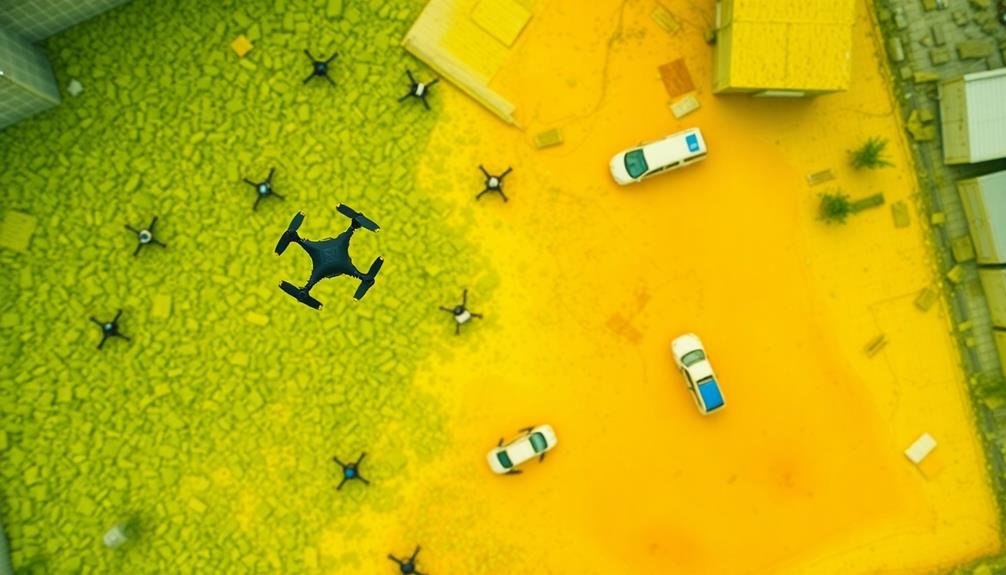
Resource allocation optimization stands at the heart of effective swarm technology for disaster evaluations.
You'll find that swarm-based systems excel at distributing resources efficiently across vast disaster-stricken areas. By leveraging the collective intelligence of numerous autonomous units, you can achieve a level of adaptability and responsiveness that's unmatched by traditional methods.
These swarms can quickly identify areas of greatest need and redirect resources accordingly. You'll see drones, robots, and sensors working in tandem, constantly reassessing priorities and adjusting their deployment. This dynamic approach guarantees that essential supplies, medical aid, and rescue efforts are always directed where they're most needed.
You'll benefit from the swarm's ability to process real-time data and make split-second decisions. It can account for changing conditions, such as weather patterns or shifting debris, and optimize resource allocation on the fly.
This flexibility allows you to maximize the impact of limited resources during vital early response phases.
Integration With Existing Systems

While optimizing resource allocation is key, the true power of swarm technology in disaster evaluations comes from its seamless integration with existing systems. You'll find that swarm-based solutions can easily connect with your current infrastructure, enhancing rather than replacing it. This integration allows for a smoother shift and faster adoption of the technology.
When you incorporate swarm technology into your existing disaster response framework, you'll benefit from:
- Enhanced data collection and analysis capabilities
- Improved communication between different agencies and teams
- Real-time updates and decision-making support
You'll notice that swarm technology doesn't just work alongside your current systems; it amplifies their effectiveness. It can fill gaps in your existing processes, providing a more thorough view of the disaster situation.
By integrating swarm technology, you're not just adding another tool to your arsenal; you're creating a more robust, adaptive, and efficient disaster evaluation system.
This seamless integration guarantees that you can leverage the full potential of swarm technology without disrupting your established procedures. You'll be able to make more informed decisions, respond faster, and ultimately save more lives in the aftermath of large-scale disasters.
Cost-Effectiveness of Swarm Deployments

Cost considerations often dominate disaster response planning, but swarm technology offers a surprisingly economical solution. When you deploy swarms of small, inexpensive drones or robots, you'll find that the overall cost is considerably lower than traditional methods.
These swarms can cover vast areas quickly, reducing the need for costly human personnel and expensive specialized equipment.
You'll see substantial savings in maintenance and replacement costs. If a single unit in the swarm fails, it's easily and cheaply replaced without compromising the mission. This redundancy guarantees continuous operation, eliminating costly downtime.
Additionally, you'll benefit from reduced training expenses, as swarm algorithms can be updated centrally and deployed across the entire fleet instantly.
The scalability of swarm technology allows you to adjust deployments based on the disaster's scope, optimizing resource allocation.
You'll also save on transportation costs, as swarms can be locally stored and rapidly mobilized.
Frequently Asked Questions
How Does Swarm Technology Handle Data Security and Privacy Concerns?
You'll find that swarm technology employs encryption, distributed storage, and access controls to protect data. It also uses anonymization techniques and guarantees data is fragmented across multiple nodes, enhancing security and privacy in the swarm network.
What Are the Ethical Implications of Using Swarm Technology in Disaster Zones?
You'll face ethical challenges when using swarm technology in disaster zones. You're dealing with privacy concerns, potential misuse of data, and the risk of dehumanizing victims. You must balance efficiency with respect for human dignity and autonomy.
How Do Weather Conditions Affect Swarm Technology Performance During Evaluations?
You'll find that weather conditions considerably impact swarm technology. Wind can disrupt flight patterns, while rain or snow may interfere with sensors. Extreme temperatures can affect battery life, potentially limiting the swarm's operational time in disaster zones.
Can Swarm Technology Be Used for Search and Rescue Operations?
You can definitely use swarm technology for search and rescue operations. It's incredibly effective for covering large areas quickly. You'll deploy multiple drones or robots that work together, scanning the terrain and relaying information back to rescue teams.
What Training Is Required for Personnel to Operate Swarm Technology Effectively?
You'll need training in swarm algorithms, robotic control systems, and data analysis. It's vital to understand swarm behavior, mission planning, and communication protocols. Hands-on practice with simulation software and real swarm deployments is essential for effective operation.
In Summary
You've seen how swarm technology transforms disaster evaluations. It's revolutionizing the field with rapid data collection, wide coverage, and real-time mapping. You'll appreciate its obstacle avoidance in challenging terrains and robust communication networks. It's optimizing resource allocation and integrating seamlessly with existing systems. Best of all, you'll find it's cost-effective. As you move forward, remember that swarm technology isn't just an innovation—it's a game-changer in large-scale disaster response.
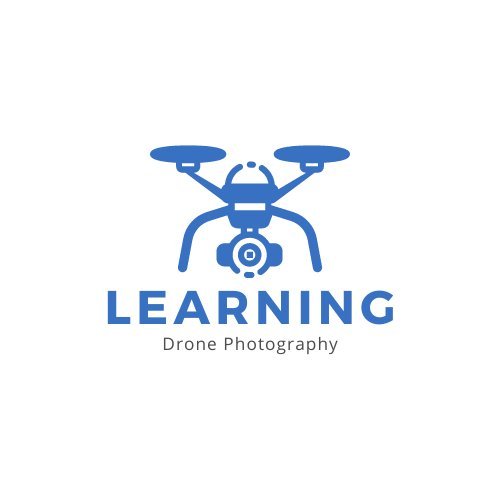
As educators and advocates for responsible drone use, we’re committed to sharing our knowledge and expertise with aspiring aerial photographers.

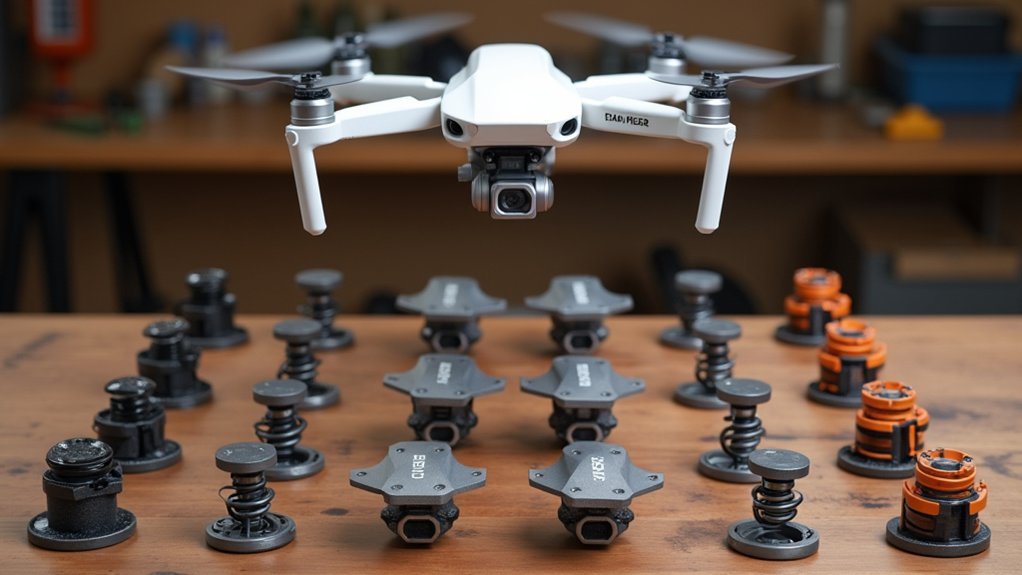
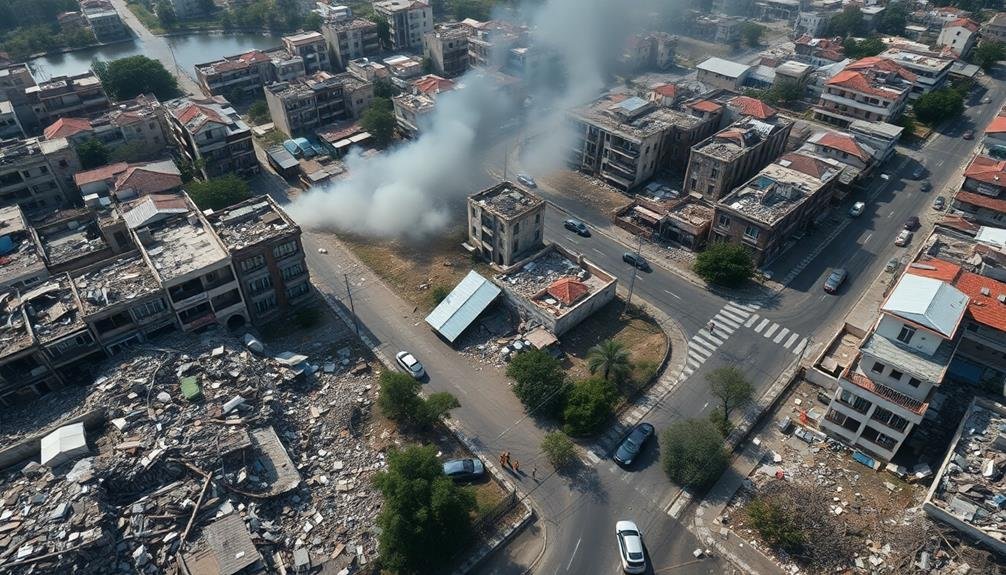
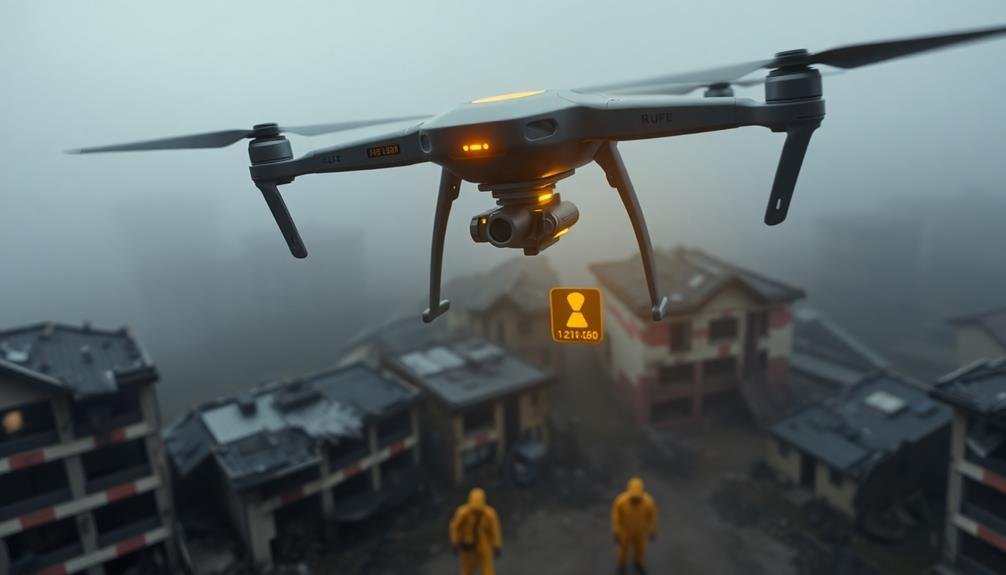
Leave a Reply